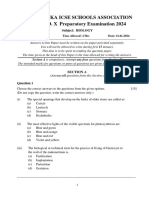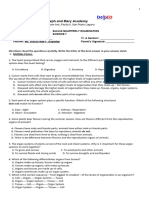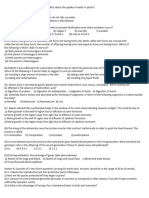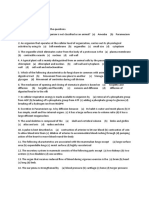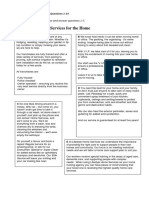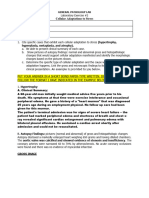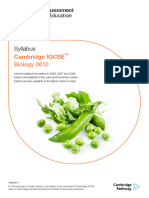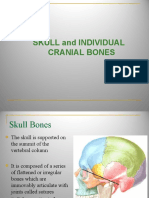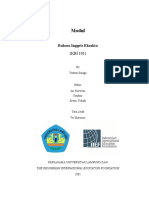BOSCO PUBLIC SCHOOL
PRACTICE ASSIGNMENT (2024-25)
CLASS: X
SUBJECT: BIOLOGY
SECTION A
The following are 1mark questions
1. Which of the following option shows the order of events correctly when a bright light is focused 1
on our eyes?
(a) Bright light → receptors in eyes → sensory neuron→ spinal cord → motor neurons → eyelid
closes
(b) Bright light → receptors in eyes → spinal cord → sensory neuron → motor neurons →
eyelid closes
(c) Bright light → receptors in eyes → sensory neuron → motor neurons → spinal cord → eyelid
closes
(d) Bright light → receptors in eyes → spinal cord→ motor neurons → sensory neuron → eyelid
closes
2. When we touch the leaves of the “touch-me-not” plant, they begin to fold up and droop. How 1
does the plant communicate the information of touch?
(a) The plant uses electrical signals to transfer information from the external environment to
cells.
(b) The plant uses electrical-chemical signals to transfer information from cell to cell.
(c) The plant uses electrical-chemical signals to transfer information from tissue to specialised
cells.
(d) The plant uses electrical signals to transfer information from cells to specialised tissues.
3. Which of the following option illustrates the location of the centre that controls the feelings 1
associated with hunger (M) and the centre that allows a person to walk in a straight line (N)?
� (c)
4. In an ecosystem, the 10% of energy available for transfer from one trophic level to the next is in 1
the form of_______.
(a) heat energy (b) light energy (c) chemical energy (d) mechanical energy
5. Which of the following is not a life process? 1
(a) Respiration (b) Reproduction (c) Transpiration (d) Photosynthesis
6. Which of the following is the functional unit of the lung? 1
(a) Bronchus (b) Alveoli (c) Bronchiole (d) Trachea
7. Assertion (A): The sex of a child in human beings will be determined by the type of 1
chromosome he/she inherits from the father.
Reason (R): A child who inherits ‘X’ chromosome from his father would be a girl (XX), while a
child who inherits a ‘Y’ chromosome from the father would be a boy (XY).
(a) Both (A) and (R) are true and (R) is the correct explanation of the assertion (A).
(b) Both (A) and (R) are true, but (R) is not the correct explanation of the assertion (A).
(c) (A) is true, but (R) is, false.
(d) (A) is false, but (R) is true.
8. Assertion(A): Variations are seen in offspring produced by sexual reproduction. 1
Reason (R): DNA molecule generated by replication is not exactly identical to original DNA.
(a) Both A and R are true and R is the correct explanation of A.
(b) Both A and R are true but R is not the correct explanation of A.
(c) A is true but R is false.
(d) A is false but R is true.
9. Assertion (A): Pea plant is considered ideal for hybridisation experiments. 1
Reason (R): Pea is self- pollinating plant with short life cycle and bears visible contrasting traits.
(a) Both A and R are true and R is the correct explanation of A.
(b) Both A and R are true but R is not the correct explanation of A.
(c) A is true but R is false.
(d) A is false but R is true.
10. Assertion (A): Ozone is formed in upper atmosphere by O2 in presence of UV radiations. 1
Reason (R): Ozone depletion will lead to UV rays reaching earth which may cause skin cancer.
� (a) Both ‘A’ and ‘R’ are true and ‘R’ is correct explanation of the Assertion.
(b) Both ‘A’ and ‘R’ are true but ‘R’ is not correct explanation of the Assertion.
(c) ‘A’ is true but ‘R’ is false.
(d) ‘A’ is false but ‘R’ is true.
SECTION B
The following are 2mark questions
11. What is placenta? Give the significance of placenta. 2
12. What happens if the ovum does not get fertilized in female body? 2
13. How does study of food chain in an area or habitat help us? 2
14. Rahul was bitten by a snake in his farm last year. His father called a snake charmer and asked 2
him to catch as many snakes as possible. After a year, the family is facing the problem of rats that
are destroying their crops.
(a) What is the relation between catching of snakes and destruction of crops by the rats?
(b) What is meant by trophic level?
15. What is meant by tropic movements? State one example of chemotropism. 2
16. What are plant hormones? Name the plant hormones responsible for the following: 2
(a) Growth of stem (b) Promotion of cell division (c) Inhibition of growth (d) Elongation of cells
17. State the role played by the following in the process of digestion: 2
(a) Enzyme trypsin (b) Enzyme lipase.
18. Name the two types of blood vessels which transports oxygenated and deoxygenated blood with 2
one important feature of each.
19. List two differences in tabular form between dominant trait and recessive traits. What 2
percentage/proportion of the plants in the F2 generation/progeny were round, in Mendel’s cross
between round and wrinkled pea plants?
20. “It is a matter of chance whether a couple will have a male or a female child.” Justify this 2
statement by drawing a flow chart.
SECTION C
The following are 3mark questions
21. Give the functions of the following- (a) ovaries (b) testes (c) uterus. 3
22. How do sperms reach the female genital tract? Where does fertilization and implantation of 3
the embryo take place? For how long does the embryo remain attached to uterine walls?
23. Rita’s mother bought oranges from the market. She left them on a humid shelf. Next day she 3
observed greenish black patches on some of the oranges.
(a) What was the probable cause of the patches?
(b) How did the oranges get infested?
(c) What precautions should be taken to avoid this?
24. What is vegetative propagation? Give examples of plants which can be propagated by their: 3
(a) stems (b) roots (c) leaves.
25. (a) How much energy will be available to hawks in the food chain comprising hawk, snake, 3
paddy and mice, if 10,000 J of energy is available to paddy from the sun?
(b) Which of the following belong to the same trophic level?
Tree, Frog, Snake, Grass, Lizard
26. Give reasons for the following: 3
(a) The lung alveoli are covered with blood capillaries.
(b) The wall of trachea is supported by cartilage rings.
(c) Rate of breathing is higher in aquatic animals as compared to terrestrial animals.
27. “Reflex arcs continue to be more efficient for quick responses”. Justify this statement giving 3
reason.
28. Mention three major regions of brain. Write one function of each. 3
29. (a) Why did Mendel carry out an experiment to study inheritance of two traits in garden pea? 3
(b) What were his findings with respect to inheritance of traits in F1 and F2 generation?
(c) State the ratio obtained in the F2 generation in the above mentioned experiment.
�30. (a) Why is the F1 progeny always of tall plants when a tall plant is crossed with a short pea plant? 3
(b) How is F2 progeny obtained by self-pollination of F1 progeny different from F1 progeny?Give
reason for this observation.
(c) State a conclusion that can be drawn on the basis of this observation.















